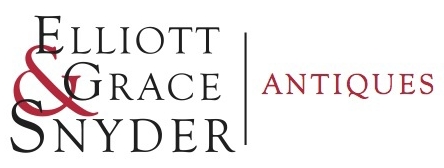L: A very rare brass trumpet-shaped taperstick in superb condition. England, c. 1650-60; 3 1/4” h. SOLD.
R: A very fine brass trumpet stick in an unusual small size; in excellent condition. England, c. 1650-60; 5” h. SOLD.
Very Rare Delft Plate
An extremely rare. 18th c. English delft plate depicting a pottery kiln bellowing smoke. A similar plate is in the collection of Colonial Williamsburg and is pictured in Austin, British Delft at Williamsburg, p. 151, and another is in the collection of the Fitzwilliam museum.
Bristol, c. 1750; 7 7/8” diam.
In excellent condition with minor fritting on rim.
SOLD.
Rare Folding Bookstand
An ingeniously crafted, carved folding oak bookstand, initialed and dated “JW 1742.”
England, 1742 or possibly earlier, with initials and date added in 1742.
In excellent condition.
12 3/4” h. (open) x 10 1/2” w.
SOLD.
Beautifully Designed Chopper
A beautifully designed steel and wood food chopper, probably intended as a betrothal or wedding gift, with the blade surmounted by two lovebirds.
England, 2nd half 19th c.
In excellent condition, with the brass head of one pin missing on one side.
10 1/4” h. x 8 3/4” w.
SOLD.
Diminutive Leather Costrel
A rare 17th c. English leather costrel in an unusually small size.
In excellent condition.
5 1/2” h. x 4” d. x 5” l.
SOLD.
A Rare Pair
A very fine pair of ribbed brass trumpet sticks in excellent condition.
England, c. 1660.
7 1/4” h., base diameter 5 1/2”.
No repairs or restoration.
SOLD.
A "True" Sampler
A remarkable compendium of mid-18th c. decorative needlework patterns surrounding a “pastoral” tablet, under a small panel dated “1752”.
Probably Swedish, 1752.
In an unusually large format; in excellent color and condition.
34” x 24 1/4” (framed).
An old note on the back indicates this piece is Swedish and was purchased in Stockholm in 1886.
SOLD.
Vibrant Delft Plaque
A charming 18th c. Dutch Delft plaque depicting a milkmaid milking a “hobbled” cow. “Hobbling” refers to the practice of tying together the back lower legs of the cow when milking to minimize potential mishaps. The central panel, drawn completely in blue, is juxtaposed against a vibrant polychrome border, creating an unusually artful object.
Netherlands, c. 1760.
8 3/4” square.
In excellent condition with minor glazing fritting on edges.
SOLD.
Extremely Rare Diminutive Signed Skillet
A very small and very rare mid 17th c. English bronze skillet signed on the handle “John Reeve." As Roderick Butler and Christopher Green note in their book English Bronze Cooking Vessels and Their Founders 1350-1830, p. 90, where they picture an almost identical piece, little is known about John Reeve and only one other skillet is known by him, which is undoubtedly this one. Judging from various stylistic elements, legs and hooved feet, open brace under handle, this was undoubtedly made in southeast England—Kent or Sussex and most likely c. 1640-70. 7 5/8” l (to tip of handle) x 3” h. x 3 1/2” bowl diameter.
Provenance: Longridge Collection; Christopher Bangs Collection
SOLD.
Oak Footwarmer
A deeply carved early 18th c. foot warmer with chip-carved corners, in original red wash; with original handle, and hardware.
Probably American, possibly English or Dutch.
7 1/4” sq. (body).
In very fine condition with small chip to edge of one corner of top molding.
SOLD.
Diminutive Iron and Engraved Brass Tinder Pistol/Lighter
A very fine tinder lighter with candleholder in an unusually small size with a rare engraving depicting the front of a galloping horse.
Variously attributed to England or Germany, c. 1690-1720.
6” l. x 3” h.
In excellent condition.
Ex. coll. Bill Samaha.
SOLD.
English Brass Candlesticks
An extremely robust pair of early English seamed brass candlesticks in excellent condition.
English, c. 1690-1710.
8 3/4” h.
SOLD.
Charming Watercolor Schoolgirl Box
For those who love New England architecture—a charming watercolor schoolgirl box of unusual form and design. Said to have come from a house in St. Johnsbury, Vermont, this box is on original turned feet, and has a compartmentalized interior.
Vermont, c. 1820-30.
In excellent condition.
9” l. x 4 1/4” h. x 6 3/4” d.
SOLD.
Slipware Deep Dish
A large and very dramatic slipware deep dish.
English, 2nd half 18th c.
15” diam.
No repairs or restoration.
SOLD.
16th C. Nuremberg Candlestick
Superb quality and condition. A 16th c. candlestick of rare form with great detail and wonderful patina.
Prob. Nuremberg, Germany, c. 1550.
8 3/4” h.
SOLD.
A Rare Form!
A late 18thc. -early 19h c. American brass punchbowl ladle signed “R. Lee."
Richard Lee ( 1775-1858) worked in Springfield, VT 1795-1815, and in Beverly, MA 1816-20. He was the son of itinerant pewterer Richard Lee Sr. who worked in NH, MA, and Springfield, VT 1773-1823.
In excellent condition.
9 3/4” l.
SOLD.
"Bee Constant"
A rare motto skillet by Thomas Sturton I the founder of the Sturton Foundry in South Petherton, Somerset (fl. 1630-58), or possibly by his son Thomas II. A skillet with the same mark is dated 1648. These somewhat predate the more common motto skillets from the Fathers Foundry, also in Somerset. This example has the quatrefoil scratch mark of the Sturton Foundry.
8” diam.
For more information, cf. Butler and Green, English Bronze Cooking Vessels 1350-1830.
SOLD.
16th C. Dutch Heemskerk Candlestick
A very fine early 16th c. Dutch heemskerk with no repairs or restoration. The ribbing is in virtually mint condition.
Netherlands, c. 1500.
7 3/4’ H.
SOLD.
Steel Meat Fork
A very fine steel meat fork with oversized central heart.
England, c. 1680-1710.
In excellent condition.
21” l.
SOLD.
A Wrought Iron Trivet
A beautifully designed wrought iron trivet featuring a series of stepped hearts.
American, c. 1780-1820.
In excellent condition.
9 1/4."
SOLD.

